publications
publications by categories in reversed chronological order. generated by jekyll-scholar.
2025
-
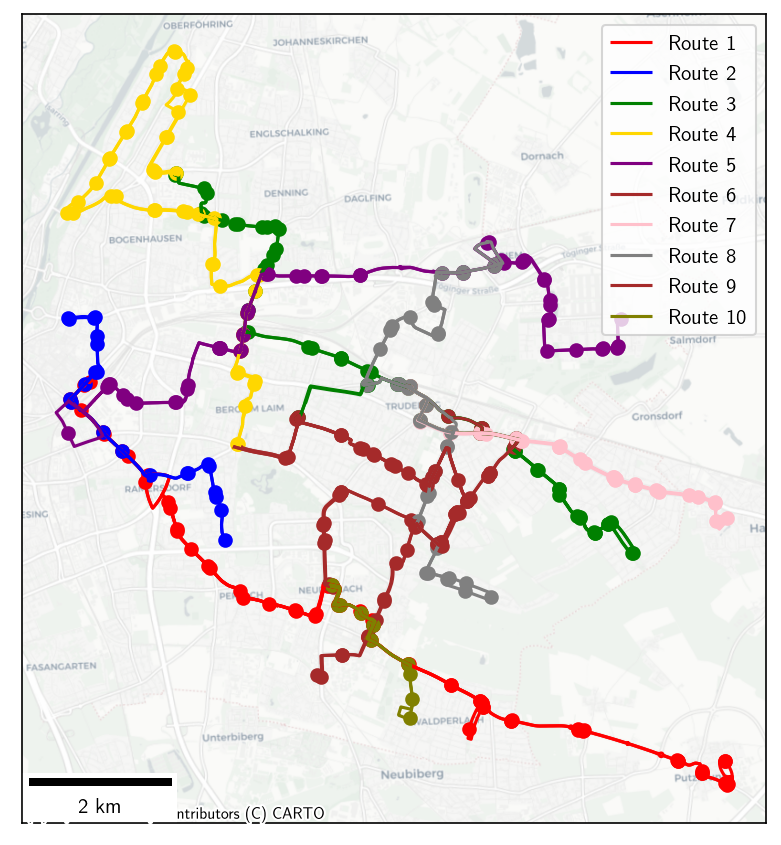 Semi-on-Demand Off-Peak Transit Services with Shared Autonomous Vehicles – Service Planning, Simulation, and Analysis in Munich, GermanyMax T. M. Ng, Roman Engelhardt, Florian Dandl, Vasileios Volakakis, Hani S. Mahmassani, and Klaus BogenbergerIn 104th Transportation Research Board Annual Meeting, 2025
Semi-on-Demand Off-Peak Transit Services with Shared Autonomous Vehicles – Service Planning, Simulation, and Analysis in Munich, GermanyMax T. M. Ng, Roman Engelhardt, Florian Dandl, Vasileios Volakakis, Hani S. Mahmassani, and Klaus BogenbergerIn 104th Transportation Research Board Annual Meeting, 2025This study investigates the implementation of semi-on-demand (SoD) hybrid-route services using Shared Autonomous Vehicles (SAVs) on existing transit lines. SoD services combine the cost efficiency of fixed-route buses with the flexibility of on-demand services. SAVs first serve all scheduled fixed-route stops, then drop off and pick up passengers in the pre-determined flexible-route portion, and return to the fixed route. This study addresses four key questions: optimal fleet and vehicle sizes for peak-hour fixed-route services with SAVs and during transition (from drivers to autonomous vehicles), optimal off-peak SoD service planning, and suitable use cases. The methodology combines analytical modeling for service planning with agent-based simulation for operational analysis. We examine ten bus routes in Munich, Germany, considering full SAV and transition scenarios with varying proportions of drivers. Our findings demonstrate that the lower operating costs of SAVs improve service quality through increased frequency and smaller vehicles, even in transition scenarios. The reduced headway lowers waiting time and also favors more flexible-route operation in SoD services. The optimal SoD settings range from fully flexible to hybrid routes, where higher occupancy from the terminus favors shorter flexible routes. During the transition phase, limited fleet size and higher headways constrain the benefits of flexible-route operations. The simulation results corroborate the SoD benefits of door-to-door convenience, attracting more passengers without excessive detours and operator costs at moderate flexible-route lengths, and validate the analytical model.
@inproceedings{ng_semi-on-demand_2025, title = {Semi-on-{Demand} {Off}-{Peak} {Transit} {Services} with {Shared} {Autonomous} {Vehicles} -- {Service} {Planning}, {Simulation}, and {Analysis} in {Munich}, {Germany}}, doi = {10.48550/arXiv.2408.10547}, booktitle = {104th {Transportation} {Research} {Board} {Annual} {Meeting}}, author = {Ng, Max T. M. and Engelhardt, Roman and Dandl, Florian and Volakakis, Vasileios and Mahmassani, Hani S. and Bogenberger, Klaus}, year = {2025}, address = {Washington, D.C.}, } -
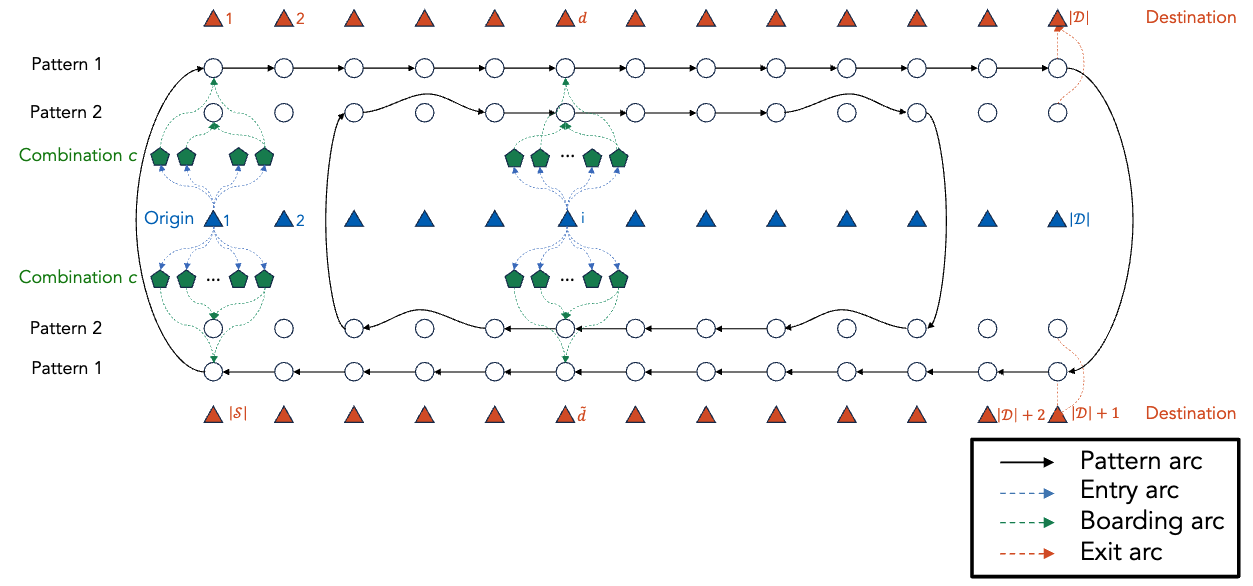 Joint Optimization of Pattern, Headway, and Fleet Size of Multiple Urban Transit Lines with Perceived Headway Consideration and Passenger Flow AllocationIn 104th Transportation Research Board Annual Meeting, 2025
Joint Optimization of Pattern, Headway, and Fleet Size of Multiple Urban Transit Lines with Perceived Headway Consideration and Passenger Flow AllocationIn 104th Transportation Research Board Annual Meeting, 2025This study addresses the urban transit pattern design problem, optimizing stop sequences, headways, and fleet sizes across multiple routes simultaneously to minimize user costs (composed of riding, waiting, and transfer times) under operational constraints (e.g., vehicle capacity and fleet size). A destination-labeled multi-commodity network flow (MCNF) formulation is developed to solve the problem at a large scale more efficiently compared to the previous literature. The model allows for flexible pattern options without relying on pre-defined candidate sets and simultaneously considers multiple operational strategies such as express/local services, short-turning, and deadheading. It evaluates perceived headways of joint patterns for passengers, assigns passenger flows to each pattern accordingly, and allows transfers across patterns in different directions. The mixed-integer linear programming (MILP) model is demonstrated with a city-sized network of metro lines in Chicago, USA, achieving near-optimal solutions in hours. The total weighted journey times are reduced by 0.61% and 4.13% under single-route and multi-route scenarios respectively. The model provides transit agencies with an efficient tool for comprehensive service design and resource allocation, improving service quality and resource utilization without additional operational costs.
@inproceedings{ng_joint_2025, address = {Washington, D.C.}, title = {Joint {Optimization} of {Pattern}, {Headway}, and {Fleet} {Size} of {Multiple} {Urban} {Transit} {Lines} with {Perceived} {Headway} {Consideration} and {Passenger} {Flow} {Allocation}}, doi = {10.48550/arXiv.2409.19068}, booktitle = {104th {Transportation} {Research} {Board} {Annual} {Meeting}}, publisher = {arXiv}, author = {Ng, Max T. M. and Tong, Draco and Mahmassani, Hani S. and Verbas, Omer and Cokyasar, Taner}, year = {2025}, keywords = {Electrical Engineering and Systems Science - Systems and Control, Mathematics - Optimization and Control}, } -
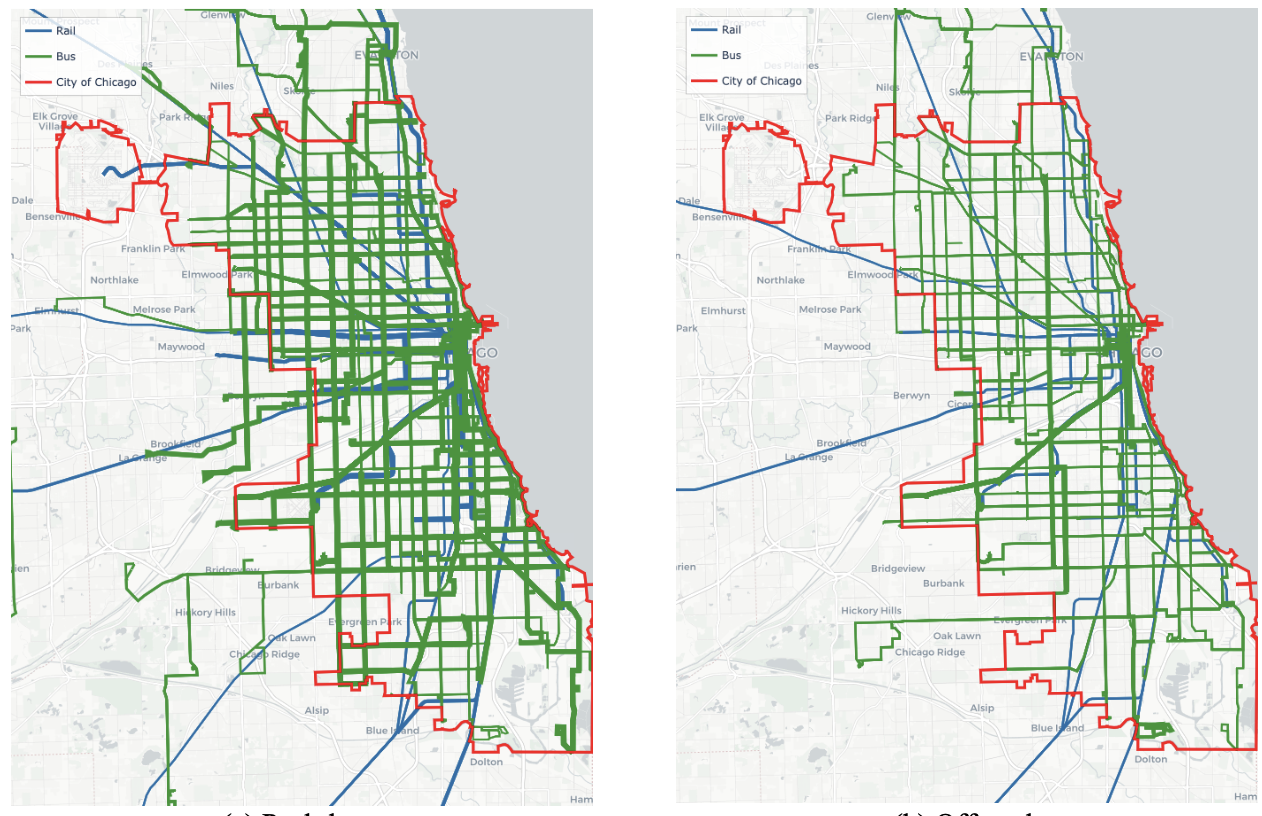 Joint Optimization of Multimodal Transit Frequency and Shared Autonomous Vehicle Fleet Size with Hybrid Metaheuristic and Nonlinear ProgrammingIn 16th International Conference on Advanced Systems in Public Transport (CASPT2025) and TransitData 2025, 2025
Joint Optimization of Multimodal Transit Frequency and Shared Autonomous Vehicle Fleet Size with Hybrid Metaheuristic and Nonlinear ProgrammingIn 16th International Conference on Advanced Systems in Public Transport (CASPT2025) and TransitData 2025, 2025This paper presents an optimization framework for the joint multimodal transit frequency and shared autonomous vehicle (SAV) fleet size optimization, a problem variant of the transit network frequency setting problem (TNFSP) that explicitly considers mode choice behavior and route selection. To address the non-linear non-convex optimization problem, we develop a hybrid solution approach that combines metaheuristics (particle swarm optimization, PSO) with local nonlinear programming (NLP) improvement, incorporating approximation models for SAV waiting time, multimodal route choice, and mode choice. Applied to the Chicago metropolitan area, our method achieves a 33.3% increase in transit ridership.
@inproceedings{ng_joint_caspt_2025, address = {Kyoto, Japan}, title = {Joint {Optimization} of {Multimodal} {Transit} {Frequency} and {Shared} {Autonomous} {Vehicle} {Fleet} {Size} with {Hybrid} {Metaheuristic} and {Nonlinear} {Programming}}, doi = {10.48550/arXiv.2412.19401}, urldate = {2025-03-10}, booktitle = {16th {International} {Conference} on {Advanced} {Systems} in {Public} {Transport} ({CASPT2025}) and {TransitData} 2025}, author = {Ng, Max T. M. and Mahmassani, Hani S. and Tong, Draco and Verbas, Omer and Cokyasar, Taner}, year = {2025}, keywords = {Computer Science - Systems and Control, Electrical Engineering and Systems Science - Systems and Control, Mathematics - Optimization and Control}, }
2024
-
 Trading off energy storage and payload – An analytical model for freight train configurationTransportation Research Part E: Logistics and Transportation Review, Jul 2024
Trading off energy storage and payload – An analytical model for freight train configurationTransportation Research Part E: Logistics and Transportation Review, Jul 2024To support planning of alternative fuel technology (e.g., battery-electric locomotives) deployment for decarbonizing non-electrified freight rail, we develop a convex optimization formulation with a closed-form solution to determine the optimal number of energy storage tender cars in a train. The formulation shares a similar structure to an Economic Order Quantity (EOQ) model. For given market characteristics, cost forecasts, and technology parameters, our model captures the trade-offs between inventory carrying costs associated with trip times (including delays due to charging/refueling) and ordering costs associated with train dispatch and operation (energy, amortized equipment, and labor costs). To illustrate the framework, we find the optimal number of battery-electric energy tender cars in 22,501 freight markets (origin–destination pairs and commodities) for U.S. Class I railroads. The results display heterogeneity in optimal configurations with lighter, yet more time-sensitive shipments (e.g., intermodal) utilizing more battery tender cars. For heavier commodities (e.g., coal) with lower holding costs, single battery tender car configurations are generally optimal. The results also show that the optimal train configurations are sensitive to delays associated with recharging or swapping tender cars.
@article{ng_trading_2024, title = {Trading off energy storage and payload – {An} analytical model for freight train configuration}, volume = {187}, issn = {1366-5545}, doi = {10.1016/j.tre.2024.103601}, urldate = {2024-05-25}, journal = {Transportation Research Part E: Logistics and Transportation Review}, author = {Ng, Max T. M. and Hernandez, Adrian and Durango-Cohen, Pablo L. and Mahmassani, Hani S.}, month = jul, year = {2024}, keywords = {Battery tender, Battery-electric, Decarbonization, Energy storage tender cars, Rail freight}, pages = {103601}, } -
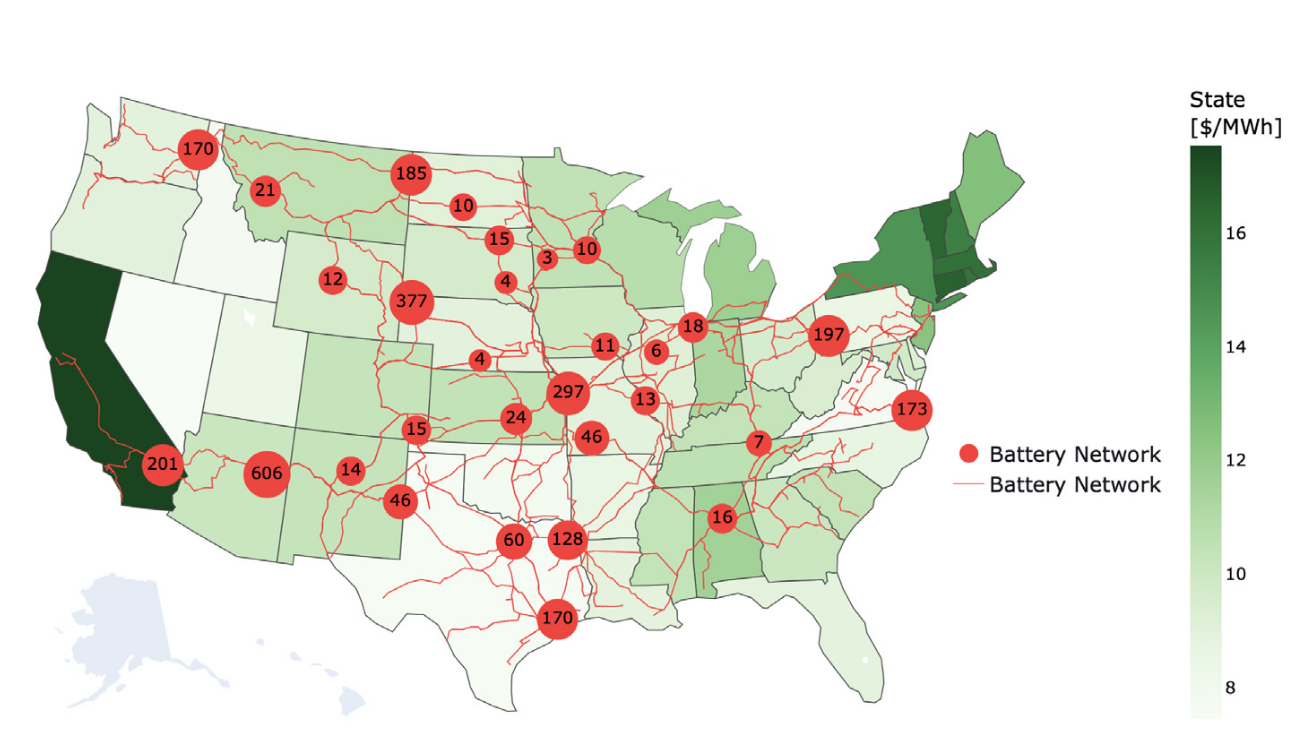 Optimizing service networks to support freight rail decarbonization: Flow selection, facility location, and energy sourcingEuropean Journal of Operational Research, Apr 2024
Optimizing service networks to support freight rail decarbonization: Flow selection, facility location, and energy sourcingEuropean Journal of Operational Research, Apr 2024We present a framework to support decarbonization of energy intensive transportation systems offering periodic service on expansive networks (e.g., freight rail, trucking, and intercity bus services). The framework consists of two optimization problems that respectivelyaddress (i) flow selection and facility location, and (ii) energy sourcing/procurement at the service facilities to enable the selected flows. The framework generalizes mixed integer linear programming formulations for flow refueling facility location and flow-based set cover models appearing in the literature to situations where it is of interest to account for repositioning of assets along cyclical trajectories to allow for periodic service, and to account for intermediate flow capture (i.e., trip chaining). The framework also consists of a minimum cost network flow model to determine optimal energy sourcing and distribution strategies, which dictate capacity requirements at the service facilities. The energy demands are obtained from the solution to the flow selection and facility location model. To illustrate the framework, we analyze the deployment of charging stations to support battery-electric locomotive service on a subset of the US freight rail network (i.e., an aggregate network of 3 Class I Railroads). The results show that the deployment of 30 charging stations can support battery-electric locomotives (with 1600-km ranges) to serve 86% of distance-weighted flows (ton-km) and reduce emissions by approximately 50%.
@article{hernandez_optimizing_2024, issn = {03772217}, doi = {10.1016/j.ejor.2024.04.010}, language = {en}, urldate = {2024-04-18}, journal = {European Journal of Operational Research}, author = {Hernandez, Adrian and Ng, Max and Durango-Cohen, Pablo L. and Mahmassani, Hani S.}, month = apr, year = {2024}, pages = {S0377221724002868}, } -
 Redesigning large-scale multimodal transit networks with shared autonomous mobility servicesTransportation Research Part C: Emerging Technologies, Mar 2024
Redesigning large-scale multimodal transit networks with shared autonomous mobility servicesTransportation Research Part C: Emerging Technologies, Mar 2024This study addresses a large-scale multimodal transit network design problem, with Shared Autonomous Mobility Services (SAMS) as both transit feeders and an origin-to-destination mode. The framework captures spatial demand and modal characteristics, considers intermodal transfers and express services, determines transit infrastructure investment and path flows, and generates transit routes. A system-optimal multimodal transit network is designed with minimum total door-to-door generalized costs of users and operators, satisfying transit origin–destination demand within a pre-set infrastructure budget. Firstly, the geography, demand, and modes in each zone are characterized with continuous approximation. The decisions of network link investment and multimodal path flows in zonal connection optimization are formulated as a minimum-cost multi-commodity network flow (MCNF) problem and solved efficiently with a mixed-integer linear programming (MILP) solver. Subsequently, the route generation problem is solved by expanding the MCNF formulation to minimize intramodal transfers. The model is illustrated through a set of experiments with the Chicago network comprised of 50 zones and seven modes, under three scenarios. The computational results present savings in traveler journey time and operator cost demonstrating the potential benefits of collaboration between multimodal transit systems and SAMS.
@article{ng_redesigning_2023, title = {Redesigning large-scale multimodal transit networks with shared autonomous mobility services}, issn = {0968-090X}, doi = {10.1016/j.trc.2024.104575}, urldate = {2024-03-27}, journal = {Transportation Research Part C: Emerging Technologies}, author = {Ng, Max T. M. and Mahmassani, Hani S. and Verbas, Ömer and Cokyasar, Taner and Engelhardt, Roman}, month = mar, year = {2024}, keywords = {Autonomous vehicles, Multimodal, Network optimization, Shared Autonomous Mobility Services (SAMS), Transit network design}, pages = {104575}, } -
 Semi-on-Demand Hybrid Transit Route Design with Shared Autonomous Mobility ServicesIn 103rd Transportation Research Board Annual Meeting, Mar 2024
Semi-on-Demand Hybrid Transit Route Design with Shared Autonomous Mobility ServicesIn 103rd Transportation Research Board Annual Meeting, Mar 2024This study examines the route design of a semi-on-demand hybrid route directional service in the public transit network, offering on-demand flexible route service in low-density areas and fixed route service in higher-density areas with Shared Autonomous Mobility Service (SAMS). The study develops analytically tractable cost expressions that capture access, waiting, and riding costs for users, and distance-based operating and time-based vehicle costs for operators. Two formulations are presented for strategic and tactical decisions in flexible route portion, fleet size, headway, and vehicle size optimization, enabling the determination of route types between fixed, hybrid, and flexible routes based on demand, cost, and operational parameters. The practical applications and benefits of semi-on-demand feeders are demonstrated with numerical examples and a large-scale case study in the Chicago metropolitan area. Findings reveal scenarios in which flexible route portions serving passengers located further away reduce total costs, particularly user costs. Lower operating costs in lower-demand areas favor more flexible routes, whereas higher demand densities favor more traditional line-based operations. On two studied lines, a current cost forecast favors smaller vehicles with flexible routes, but operating constraints and higher operating costs would favor bigger vehicles with hybrid routes. The study provides an analytical tool to design SAMS as directional services and transit feeders, and tractable continuous approximation formulations for future research in transit network design.
@inproceedings{ng_semi--demand_2024, address = {Washington, D.C.}, title = {Semi-on-{Demand} {Hybrid} {Transit} {Route} {Design} with {Shared} {Autonomous} {Mobility} {Services}}, booktitle = {103rd {Transportation} {Research} {Board} {Annual} {Meeting}}, author = {Ng, Max T. M. and Dandl, Florian and Mahmassani, Hani S. and Bogenberger, Klaus}, year = {2024}, keywords = {Electrical Engineering and Systems Science - Systems and Control, Mathematics - Optimization and Control}, } -
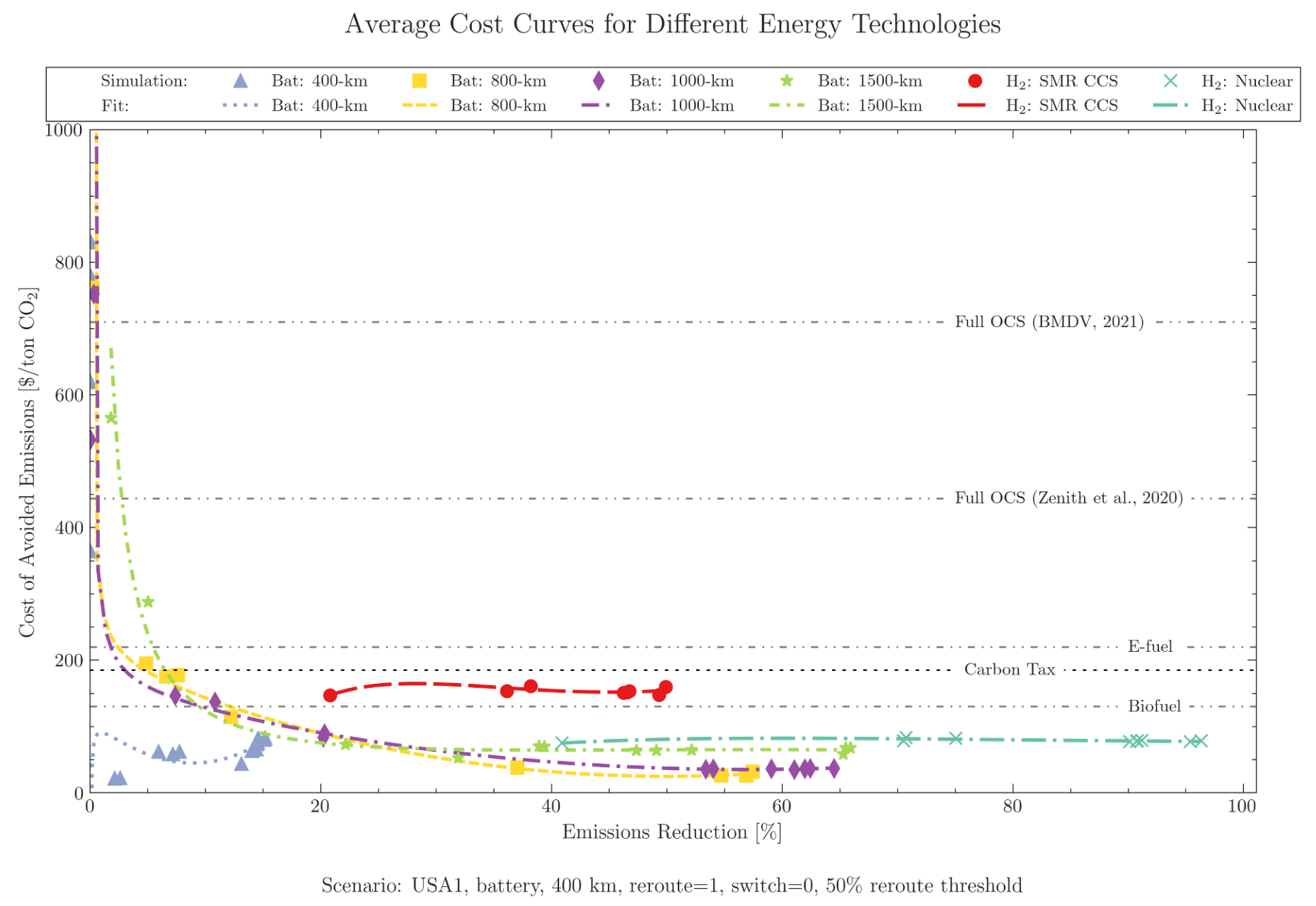 Abatement cost curve analysis of freight rail decarbonization alternativesAdrian Hernandez, Max T. M. Ng, Choudhury Siddique, Pablo L. Durango-Cohen, Hani S. Mahmassani, Amgad Elgowainy, Michael Wang, and Yan ZhouTransportation Research Part D: Transport and Environment, Sep 2024
Abatement cost curve analysis of freight rail decarbonization alternativesAdrian Hernandez, Max T. M. Ng, Choudhury Siddique, Pablo L. Durango-Cohen, Hani S. Mahmassani, Amgad Elgowainy, Michael Wang, and Yan ZhouTransportation Research Part D: Transport and Environment, Sep 2024This paper investigates decarbonization alternatives for the freight rail industry, considering economic, environmental, and operational aspects. The study compares battery-electric and hydrogen fuel cell locomotives, drop-in fuels including biofuels and e-fuels, and overhead catenary electrification through abatement cost analyses. Scenario analysis identifies the cost-effectiveness of each of the technologies at different stages of decarbonization in the US Class 1 freight railroad network. We show that though battery locomotives offer a lower-cost decarbonization option in the considered scenarios, green hydrogen fuel-powered locomotives become more attractive when battery charging delays are considered. We introduce the concept of the technology margin to cater for uncertainties in battery charging operations and hydrogen fuel production for cases where carbon taxes are imposed on railroad operations. The study provides valuable insights for policymakers and rail operators, contributing to sustainable freight rail operations.
@article{hernandez_abatement_2024, title = {Abatement cost curve analysis of freight rail decarbonization alternatives}, volume = {134}, issn = {1361-9209}, doi = {10.1016/j.trd.2024.104341}, urldate = {2024-08-06}, journal = {Transportation Research Part D: Transport and Environment}, author = {Hernandez, Adrian and Ng, Max T. M. and Siddique, Choudhury and Durango-Cohen, Pablo L. and Mahmassani, Hani S. and Elgowainy, Amgad and Wang, Michael and Zhou, Yan}, month = sep, year = {2024}, keywords = {Abatement cost, Alternative fuels, Decarbonization, Economic analysis, Freight rail}, pages = {104341}, } -
 Semi-on-Demand Transit Feeders with Shared Autonomous Vehicles and Reinforcement-Learning-Based Zonal Dispatching ControlIn 2024 IEEE 27th International Conference on Intelligent Transportation Systems (ITSC), Sep 2024
Semi-on-Demand Transit Feeders with Shared Autonomous Vehicles and Reinforcement-Learning-Based Zonal Dispatching ControlIn 2024 IEEE 27th International Conference on Intelligent Transportation Systems (ITSC), Sep 2024This paper develops a semi-on-demand transit feeder service using shared autonomous vehicles (SAVs) and zonal dispatching control based on reinforcement learning (RL). This service combines the cost-effectiveness of fixed-route transit with the adaptability of demand-responsive transport to improve accessibility in lower-density areas. Departing from the terminus, SAVs first make scheduled fixed stops, then offer on-demand pick-ups and drop-offs in a pre-determined flexibleroute area. Our deep RL model dynamically assigns vehicles to subdivided flexible-route zones in response to real-time demand fluctuations and operations, using a policy gradient algorithm — Proximal Policy Optimization. The methodology is demonstrated through agent-based simulations on a realworld bus route in Munich, Germany. Results show that after efficient training of the RL model, the semi-on-demand service with dynamic zonal control serves 16% more passengers at 13% higher generalized costs on average compared to traditional fixed-route service. The efficiency gain brought by RL control brings 2.4% more passengers at 1.4% higher costs. This study not only showcases the potential of integrating SAV feeders and machine learning techniques into public transit, but also sets the groundwork for further innovations in addressing firstmile-last-mile problems in multimodal transit systems.
@inproceedings{ng_semi--demand_2025, address = {Edmonton, AB, Canada}, title = {Semi-on-{Demand} {Transit} {Feeders} with {Shared} {Autonomous} {Vehicles} and {Reinforcement}-{Learning}-{Based} {Zonal} {Dispatching} {Control}}, isbn = {979-8-3315-0592-9}, doi = {10.1109/ITSC58415.2024.10920214}, language = {en}, urldate = {2025-03-23}, booktitle = {2024 {IEEE} 27th {International} {Conference} on {Intelligent} {Transportation} {Systems} ({ITSC})}, publisher = {IEEE}, author = {Ng, Max T.M. and Engelhardt, Roman and Dandl, Florian and Mahmassani, Hani S. and Bogenberger, Klaus}, month = sep, year = {2024}, pages = {2863--2868}, }
2023
-
 City-wide Deployment of Autonomous Minibus Service with Semi-on-demand Routes in Grid Networks – Identification, Evaluation, and SimulationVasileios Volakakis, Max T. M. Ng, and Hani S. MahmassaniIn 102nd Transportation Research Board Annual Meeting, Sep 2023
City-wide Deployment of Autonomous Minibus Service with Semi-on-demand Routes in Grid Networks – Identification, Evaluation, and SimulationVasileios Volakakis, Max T. M. Ng, and Hani S. MahmassaniIn 102nd Transportation Research Board Annual Meeting, Sep 2023This paper is focused on the capability of autonomous minibuses following semi-on-demand routes, mostly in low density areas, as well as operating as fixed-route carriers, in areas with concentrated demand. 217 existing fixed bus routes from two transit agencies (PACE and CTA) in Chicago, measured by generalized costs. Bus routes with low and sparse demand can be operated as semi-on-demand routes, in contrast to routes serving a high volume of passengers in dense areas (analytical solution results). Simulation results for favorable routes to change from fixed to semi-on-demand verify the analytical solution. Analysis showed savings in passenger and agency costs (\32 and \4 million, for PACE and CTA).
@inproceedings{volakakis_city-wide_2023, address = {Washington, D.C}, title = {City-wide {Deployment} of {Autonomous} {Minibus} {Service} with {Semi}-on-demand {Routes} in {Grid} {Networks} – {Identification}, {Evaluation}, and {Simulation}}, booktitle = {102nd {Transportation} {Research} {Board} {Annual} {Meeting}}, author = {Volakakis, Vasileios and Ng, Max T. M. and Mahmassani, Hani S.}, year = {2023}, } -
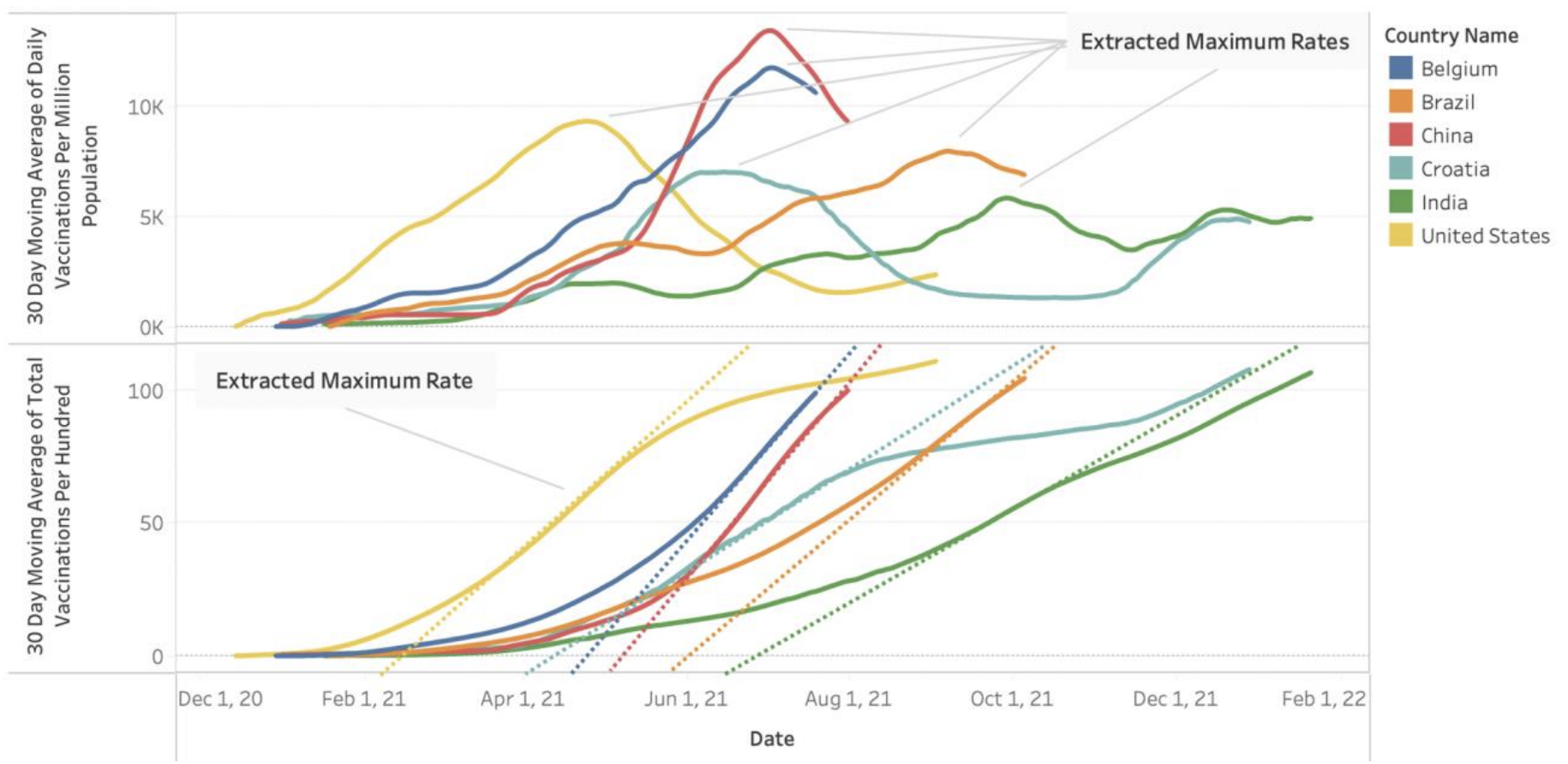 Capacity Analysis of the Global Covid-19 Vaccine Distribution Process with Econometric and Explainable Machine Learning MethodsIn 102nd Transportation Research Board Annual Meeting, Sep 2023
Capacity Analysis of the Global Covid-19 Vaccine Distribution Process with Econometric and Explainable Machine Learning MethodsIn 102nd Transportation Research Board Annual Meeting, Sep 2023The COVID-19 vaccine development, manufacturing, transportation, and administration proved an extreme logistics operation of global magnitude. Global vaccination levels, however, remain a key concern in preventing the emergence of new strains and minimizing the impact of the pandemic’s disruption of daily life. In this paper, country-level vaccination rates are analyzed through a queuing framework to extract service rates that represent the practical capacity of a country to administer vaccines. These rates are further characterized through regression and interpretable machine learning methods with country-level demographic, governmental, and socio-economic variates. Model results show that participation in multi-governmental collaborations such as COVAX may improve the ability to vaccinate. Similarly, improved transportation and accessibility variates such as roads per area for low-income countries and rail lines per area for high-income countries can improve rates. It was also found that for low-income countries specifically, improvements in basic and health infrastructure (as measured through spending on healthcare, number of doctors and hospital beds per 100k, population percent with access to electricity, life expectancy, and vehicles per 1000 people) resulted in higher vaccination rates. Of the high-income countries, those with larger 65 + populations struggled to vaccinate at high rates, indicating potential accessibility issues for the elderly. This study finds that improving basic and health infrastructure, focusing on accessibility in the last mile, particularly for the elderly, and fostering global partnerships can improve logistical operations of such a scale. Such structural impediments and inequities in global health care must be addressed in preparation for future global public health crises.
@inproceedings{hedge_capacity_2023, address = {Washington, D.C}, title = {Capacity {Analysis} of the {Global} {Covid}-19 {Vaccine} {Distribution} {Process} with {Econometric} and {Explainable} {Machine} {Learning} {Methods}}, booktitle = {102nd {Transportation} {Research} {Board} {Annual} {Meeting}}, author = {Hedge, Sharika J. and Ng, Max T. M. and Rios, Marcos and Mahmassani, Hani S. and Smilowitz, Karen}, year = {2023}, } -
 Autonomous Minibus Service With Semi-on-Demand Routes in Grid NetworksMax T. M. Ng, and Hani S. MahmassaniTransportation Research Record, Sep 2023
Autonomous Minibus Service With Semi-on-Demand Routes in Grid NetworksMax T. M. Ng, and Hani S. MahmassaniTransportation Research Record, Sep 2023This paper investigates the potential of autonomous minibuses which take on-demand directional routes for pick-up and drop-off in a grid network of wider area with low density, followed by fixed routes in areas with greater demand. Mathematical formulation for generalized costs demonstrates its benefits, with indicators proposed to select existing bus routes for conversion with the options of zonal express and parallel routes. Simulations on modeled scenarios and case studies with bus routes in Chicago show reductions in both passenger costs and generalized costs compared with existing fixed-route bus services between suburban areas and the central business district.
@article{ng_autonomous_2023, title = {Autonomous {Minibus} {Service} {With} {Semi}-on-{Demand} {Routes} in {Grid} {Networks}}, volume = {2677}, issn = {0361-1981}, doi = {10.1177/03611981221098660}, language = {en}, number = {1}, urldate = {2022-12-26}, journal = {Transportation Research Record}, author = {Ng, Max T. M. and Mahmassani, Hani S.}, year = {2023}, pages = {178--200}, } -
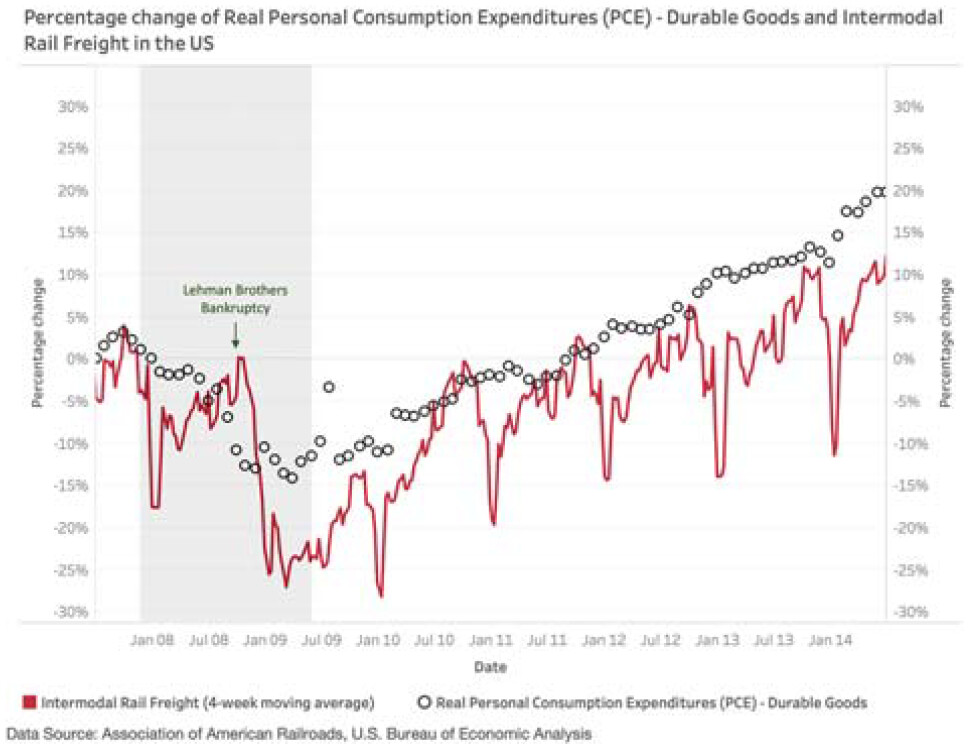 How Well Did U.S. Rail and Intermodal Freight Respond to the COVID-19 Pandemic versus the Great Recession?Max T. M. Ng, Joseph Schofer, and Hani S. MahmassaniTransportation Research Record, Mar 2023
How Well Did U.S. Rail and Intermodal Freight Respond to the COVID-19 Pandemic versus the Great Recession?Max T. M. Ng, Joseph Schofer, and Hani S. MahmassaniTransportation Research Record, Mar 2023This paper analyzes and compares patterns of U.S. domestic rail freight volumes during and after the disruptions caused by the 2007–2009 Great Recession and the...
@article{ng_how_2023, title = {How {Well} {Did} {U}.{S}. {Rail} and {Intermodal} {Freight} {Respond} to the {COVID}-19 {Pandemic} versus the {Great} {Recession}?}, copyright = {© National Academy of Sciences: Transportation Research Board 2023}, doi = {10.1177/03611981221150444}, language = {en}, urldate = {2023-03-22}, journal = {Transportation Research Record}, author = {Ng, Max T. M. and Schofer, Joseph and Mahmassani, Hani S.}, month = mar, year = {2023}, } -
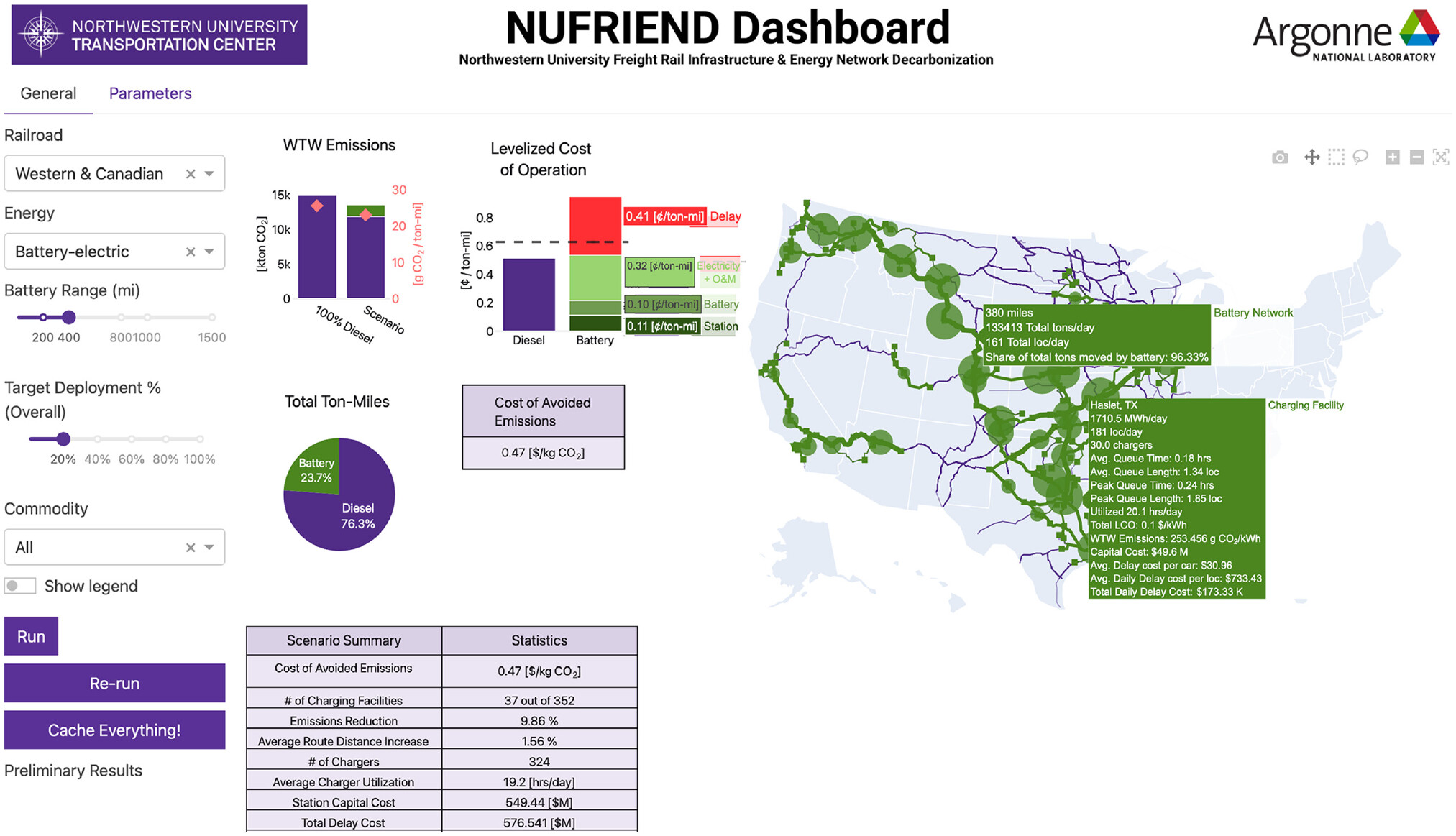 Evaluation of Rail Decarbonization Alternatives: Framework and ApplicationAdrian Hernandez, Max T. M. Ng, Nazib Siddique, Pablo L. Durango-Cohen, Amgad Elgowainy, Hani S. Mahmassani, Michael Wang, and Yan (Joann) ZhouTransportation Research Record, May 2023
Evaluation of Rail Decarbonization Alternatives: Framework and ApplicationAdrian Hernandez, Max T. M. Ng, Nazib Siddique, Pablo L. Durango-Cohen, Amgad Elgowainy, Hani S. Mahmassani, Michael Wang, and Yan (Joann) ZhouTransportation Research Record, May 2023The Northwestern University Freight Rail Infrastructure & Energy Network Decarbonization (NUFRIEND) framework is a comprehensive industry-oriented tool for simulating the deployment of new energy technologies including biofuels, e-fuels, battery-electric, and hydrogen locomotives. By classifying fuel types into two categories based on deployment requirements, the associated optimal charging/fueling facility location and sizing problem are solved with a five-step framework. Life-cycle analysis (LCA) and techno-economic analysis (TEA) are used to estimate carbon reduction, capital investments, cost of carbon reduction, and operational impacts, enabling sensitivity analysis with operational and technological parameters. The framework is illustrated on lower-carbon drop-in fuels as well as battery-electric technology deployments for the US Eastern and Western Class I railroad networks. Drop-in fuel deployments are modeled as admixtures with diesel in existing locomotives, while battery-electric deployments are shown for varying technology penetration levels and locomotive ranges. When mixed in a 50% ratio with diesel, results show biodiesel’s capacity to reduce emissions at 36% with a cost of 0.13 per kilogram of CO2 reduced, while e-fuels offer a potential reduction of 50% of emissions at a cost of 0.22 per kilogram of CO2 reduced. Battery-electric results for 50% deployment over all ton-miles highlight the value of future innovations in battery energy densities as scenarios assuming 800-mi range locomotives show an estimated emissions reduction of 46% with a cost of 0.06 per kilogram of CO2 reduced, compared with 16% emissions reduction at a cost of 0.11 per kilogram of CO2 reduced for 400-mi range locomotives. The NUFRIEND framework provides a systematic method for comparing different alternative energy technologies and identifying potential challenges and benefits in their future deployments.
@article{hernandez_evaluation_2023, title = {Evaluation of {Rail} {Decarbonization} {Alternatives}: {Framework} and {Application}}, issn = {0361-1981}, shorttitle = {Evaluation of {Rail} {Decarbonization} {Alternatives}}, doi = {10.1177/03611981231170182}, language = {en}, urldate = {2023-07-17}, journal = {Transportation Research Record}, author = {Hernandez, Adrian and Ng, Max T. M. and Siddique, Nazib and Durango-Cohen, Pablo L. and Elgowainy, Amgad and Mahmassani, Hani S. and Wang, Michael and Zhou, Yan (Joann)}, month = may, year = {2023}, pages = {03611981231170182}, } -
 Highway Managed Lane Usage and Tolling for Mixed Traffic Flows with Connected Automated Vehicles and High-Occupancy VehiclesMax T.M. Ng, and Hani S. MahmassaniTransportation Research Record, Jul 2023
Highway Managed Lane Usage and Tolling for Mixed Traffic Flows with Connected Automated Vehicles and High-Occupancy VehiclesMax T.M. Ng, and Hani S. MahmassaniTransportation Research Record, Jul 2023This paper investigates managed lane toll setting and its effect under mixed traffic of connected automated vehicles (CAVs), high-occupancy vehicles (HOVs), and human-driven vehicles (HDVs), with the goal of avoiding flow breakdown and minimizing total social cost. A mesoscopic finite difference traffic simulation model considers the flow–density relationship at different CAV market penetration rates, lane-changing behaviors, and multiple entries/exits, interacting with a reactive toll setting mechanism. The results of Monte Carlo simulation suggest an optimal policy of untolled HOV/CAV use with tolled HDVs in particular scenarios of limited CAV market penetration. Small and targeted tolling avoids flow breakdown in managed lanes while prioritizing HOVs and other vehicles with high values of time. Extensions of the formulation and sensitivity analysis quantify the benefits of converting high-occupancy HDVs to CAVs. The optimal tolling regime combines traffic science notions of flow stability and the economics of resource allocation.
@article{ng_highway_2023, title = {Highway {Managed} {Lane} {Usage} and {Tolling} for {Mixed} {Traffic} {Flows} with {Connected} {Automated} {Vehicles} and {High}-{Occupancy} {Vehicles}}, issn = {0361-1981}, doi = {10.1177/03611981231185145}, language = {en}, urldate = {2023-07-29}, journal = {Transportation Research Record}, author = {Ng, Max T.M. and Mahmassani, Hani S.}, month = jul, year = {2023}, pages = {03611981231185145}, } - ARPA-E Final Technical Report: Northwestern University Freight Rail Infrastructure and Energy Network DecarbonizationAdrian Hernandez, Max T. M. Ng, Choudhury Siddique, Pablo L. Durango-Cohen, Amgad Elgowainy, Hani Mahmassani, Michael Wang, and Yan (Joann) ZhouMay 2023
The goal of this project was to develop a tool to aid railroads and other stakeholders assess and approach the decarbonization of freight rail operations by identifying new, viable low-carbon energy storage and conversion systems for future locomotive systems and how they should be deployed on the existing US freight rail network. In the first quarter, the project focused on collecting data, establishing a simulation workflow, and engaging industry through the creation of the Industry Advisory Board (IAB). In the second quarter, the project focused on selecting fuel pathways and powertrain technologies, setting performance targets, conducting a techno-economic analyses, and developing the simulation framework that would serve as the backbone of the future toolhead. The third quarter involved developing an industry-oriented interactive dashboard powered by a five-step sequential framework, as well as holding industry advisory board meetings as per the initial technology-to-market plan. In the remaining project quarters, the NUFRIEND dashboard were fine-tuned with the help of IAB member feedback and in-depth scenario analyses were conducted to support the techno-economic analysis of energy sources. Additionally, dashboard documentation, project insights, and open-source code on GitHub were prepared and released. Throughout the project, the team completed testing and analysis of all model components, integrated all initial test scenarios, and conducted stakeholder engagement. Lower-carbon drop-in fuels can be deployed as admixtures and are considered uniform across the network at a desired penetration rate, while hydrogen and battery-electric technology deployment poses a more complex problem as they require significant investments to be made in the siting of refueling/charging facilities and the replacement of locomotive fleets. Thus, strategies for locating and sizing refueling/charging facilities on a railroad’s network to meet their energy demands were developed to inform deployment decisions. To address this challenge, the Northwestern University Freight Rail Infrastructure & Energy Network Decarbonization (NUFRIEND) framework presents a five-step sequential framework to select O-D paths, locate facilities, reroute flows, size facilities, and evaluate the deployment for alternative energy sources that require locomotive powertrains to be converted and new refueling infrastructure to be deployed.1 The NUFRIEND Framework is an industry-oriented tool for simulating the deployment of new energy technologies across the US freight rail network. The framework provides a comprehensive network-level optimization and scenario simulation tool for decarbonizing the freight rail sector, addressing the uncertainties surrounding technological developments by supporting sensitivity analyses for different operational and technological parameters through a transparent and flexible input module. It offers practical alternatives to diesel locomotives and can be applied for any railroad considering the specific network structure and freight demand, outputting evaluation metrics for the associated emissions and costs relative to diesel operations. A number of relevant simulation scenarios were run and analyzed for key insights on the value of different alternative technologies for freight rail decarbonization. The project developments and findings have been presented at numerous conferences and events.
@book{hernandez_arpa-e_2023, title = {{ARPA}-{E} {Final} {Technical} {Report}: {Northwestern} {University} {Freight} {Rail} {Infrastructure} and {Energy} {Network} {Decarbonization}}, shorttitle = {{ARPA}-{E} {Final} {Technical} {Report}}, language = {en}, urldate = {2023-09-16}, publisher = {figshare}, author = {Hernandez, Adrian and Ng, Max T. M. and Siddique, Choudhury and Durango-Cohen, Pablo L. and Elgowainy, Amgad and Mahmassani, Hani and Wang, Michael and Zhou, Yan (Joann)}, month = may, year = {2023}, doi = {10.6084/m9.figshare.22674328.v3}, }
2022
-
 Resilience of U.S. Rail Intermodal Freight during the Covid-19 PandemicJoseph L. Schofer, Hani S. Mahmassani, and Max T. M. NgResearch in Transportation Business & Management, Feb 2022
Resilience of U.S. Rail Intermodal Freight during the Covid-19 PandemicJoseph L. Schofer, Hani S. Mahmassani, and Max T. M. NgResearch in Transportation Business & Management, Feb 2022The rapid onset of the COVID-19 pandemic in March 2020 marked a challenging time for the US and its freight industry. Manufacturing slowed, consumer purchasing patterns changed, and for many, shopping moved online. The freight industry suffered a sharp decline in shipments, followed by a surprisingly quick rebound. The industry had to adapt quickly to meet fast-changing demand and supply patterns upended by global supply chain disruptions. This paper uses U.S. intermodal activity data, supported by in-depth interviews with leaders of railroads, intermodal carriers, equipment manufacturers, car leasing companies, shippers, and e-commerce players to characterize and assess how the rail industry met the challenge of this demand whiplash and other performance impediments. What emerges is a rich picture of the multi-actor intermodal supply chain, the impacts of COVID-19 on it, the performance of the logistics system in general, and railroads in particular during the pandemic. Industry interviews revealed that a handful of choke points, many of which were outside the rail industry, complicated supply chain responses to COVID-19. The paper shows how the rail industry was an essential component of pandemic resilience, demonstrating a high level of adaptability to meet consumer and business demands. Through the use of depth interviews it reveals the complexity of the intermodal supply chain, and it accurately foretells the subsequent disruptions that continued to plague that supply chain long after the initial impacts of the pandemic.
@article{schofer_resilience_2022, title = {Resilience of {U}.{S}. {Rail} {Intermodal} {Freight} during the {Covid}-19 {Pandemic}}, issn = {2210-5395}, doi = {10.1016/j.rtbm.2022.100791}, language = {en}, urldate = {2022-03-13}, journal = {Research in Transportation Business \& Management}, author = {Schofer, Joseph L. and Mahmassani, Hani S. and Ng, Max T. M.}, month = feb, year = {2022}, keywords = {Intermodal, Rail, COVID-19, Freight, E-commerce, Port, Resilience, Supply chain}, pages = {100791}, } -
 Econometric Analysis of Pandemic Disruption and Recovery Trajectory in the Rail Freight IndustryMax T. M. Ng, Hani S. Mahmassani, and Joseph L. SchoferIn 101st Transportation Research Board Annual Meeting, Feb 2022
Econometric Analysis of Pandemic Disruption and Recovery Trajectory in the Rail Freight IndustryMax T. M. Ng, Hani S. Mahmassani, and Joseph L. SchoferIn 101st Transportation Research Board Annual Meeting, Feb 2022To measure the impacts on rail and intermodal freight by economic disruptions of the 2007-09 Great Recession and the COVID-19 pandemic, this paper uses time series analysis with Seasonal AutoRegressive Integrated Moving Average (SARIMA) and covariates to model intermodal and commodity-specific freight volumes based on pre-disruption data. By comparing actual freight volumes during the disruptions against three counterfactual scenarios, Trend Continuation, Covariate-adapted Trend Continuation, and Full Covariate-adapted Prediction, the characteristics and differences in magnitude and timing between the two disruptions and their effects across nine freight components are examined.
@inproceedings{ng_econometric_2022, address = {Washington, D.C}, title = {Econometric {Analysis} of {Pandemic} {Disruption} and {Recovery} {Trajectory} in the {Rail} {Freight} {Industry}}, booktitle = {101st {Transportation} {Research} {Board} {Annual} {Meeting}}, author = {Ng, Max T. M. and Mahmassani, Hani S. and Schofer, Joseph L.}, year = {2022}, }
2021
- The U.S. Railroads and COVID-19: Keeping Supply Chains MovingJun 2021
The rapid onset of the COVID-19 pandemic in March 2020 marked a challenging time for the country and the U.S. freight industry. Manufacturing slowed, consumer purchasing patterns changed, and for many, shopping moved online. The freight industry suffered a sharp decline in shipments, followed by a surprisingly quick rise. The movement of goods by freight rail had to quickly adapt to meet dynamically changing demand and volatile supply patterns. Despite this disruption, freight rail showed a great deal of resilience and reliability. This report addresses how the rail industry met the challenge of this whiplash in demand, explores impediments to performance during this period and looks beyond the crisis towards the future for the rail sector. The assessment outlined in this report was completed by researchers at Northwestern University’s Transportation Center (NUTC). The results show how the U.S. freight rail industry was an essential component of pandemic resilience, demonstrating a high level of adaptability to meet consumer and business demands.
@book{schofer_us_2021, title = {The {U}.{S}. {Railroads} and {COVID}-19: {Keeping} {Supply} {Chains} {Moving}}, shorttitle = {The {U}.{S}. {Railroads} and {COVID}-19}, language = {en}, urldate = {2022-06-03}, publisher = {figshare}, author = {Schofer, Joseph and Mahmassani, Hani and Ng, Max T. M. and Johnson, Breton}, month = jun, year = {2021}, }
2013
- Transit Network Design: a Hybrid Enhanced Artificial Bee Colony Approach and a Case StudyInternational Journal of Transportation Science and Technology, Sep 2013
A bus network design problem in a suburban area of Hong Kong is studied. The objective is to minimize the weighted sum of the number of transfers and the total travel time of passengers by restructuring bus routes and determining new frequencies. A mixed integer optimization model is developed and was solved by a Hybrid Enhanced Artificial Bee Colony algorithm (HEABC). A case study was conducted to investigate the effects of different design parameters, including the total number of bus routes available, the maximum route duration within the study area and the maximum allowable number of bus routes that originated from each terminal. The model and results are useful for improving bus service policies.
@article{jiang_transit_2013, title = {Transit {Network} {Design}: a {Hybrid} {Enhanced} {Artificial} {Bee} {Colony} {Approach} and a {Case} {Study}}, volume = {2}, issn = {2046-0430}, shorttitle = {Transit {Network} {Design}}, doi = {10.1260/2046-0430.2.3.243}, language = {en}, number = {3}, urldate = {2022-06-03}, journal = {International Journal of Transportation Science and Technology}, author = {Jiang, Y. and Szeto, W. and Ng, T.}, month = sep, year = {2013}, keywords = {Transit network design, Heuristic, Artificial bee colony algorithm}, pages = {243--260}, }